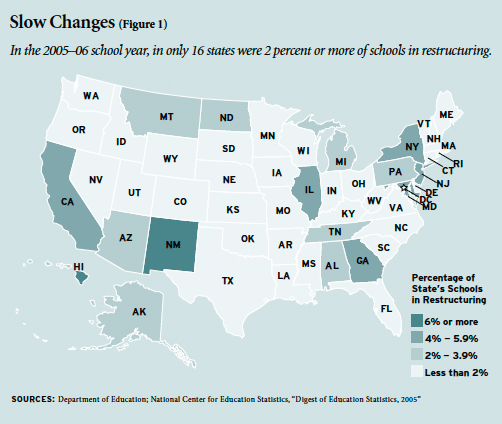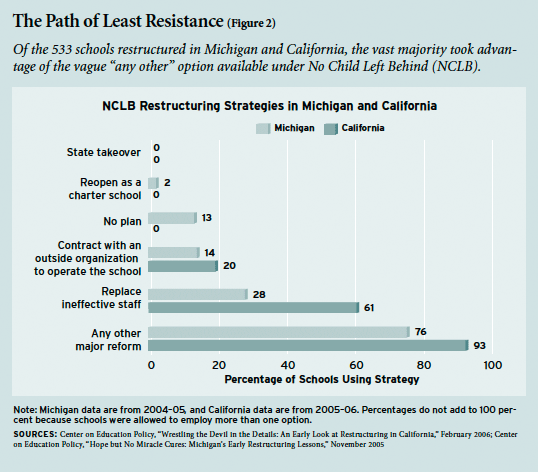
The passage of the No Child Left Behind Act (NCLB) in 2001 brought new urgency to the task of turning around low-performing schools. Under the law, states must evaluate schools according to the standard of Adequate Yearly Progress (AYP). Schools that do not meet AYP are identified as needing improvement and subject to a series of escalating interventions. These interventions begin with school choice and supplemental tutoring for students in the low-performing school. They culminate in possible closure, state takeover, privatization, or conversion to a charter school—controversial consequences highlighted in newspaper articles about the law.
While many schools have been identified as needing improvement under NCLB, only a small percentage have failed to make progress for long enough—six years—to be subject to restructuring, the most serious consequence for schools under the law (see Figure 1). In the 2005–06 school year—the fourth year since passage of NCLB—there were some 1,750 schools in 42 states in NCLB restructuring. That number is expected to grow dramatically over the next few years. As schools move along the school improvement timeline and standards rise toward the goal of having all students proficient, states and school districts face questions about how aggressively to act when schools persistently fail to perform.
The Roots of NCLB
The No Child Left Behind Act was not the first federal legislation that sought to catalyze change in chronically low-performing schools. It builds on school improvement provisions in its predecessor, the Improving America’s Schools Act of 1994 (IASA), which first required states and school districts to identify schools in need of school improvement. Schools that continued to perform poorly were identified for corrective action, a more aggressive intervention. Later Clinton initiatives targeted federal resources to improve low-performing schools.
IASA’s school improvement measures proved disappointing to many reformers. By 2001, it was increasingly clear that many schools were stagnating on school improvement and corrective action lists with little change. In fact, some did not even know they were on the lists at all.
The authors of the No Child Left Behind Act wanted to force districts and states to take more aggressive steps to improve low-performing schools. They added a third layer of consequences—restructuring—for schools that continue to perform poorly even after several years of school improvement and corrective action. After a school fails to make AYP for five consecutive years, it must develop a restructuring plan, which goes into action if the school fails to make AYP for a sixth consecutive year. NCLB provides several options for schools in restructuring:
• Close and reopen as a charter school
• Replace relevant school staff
• Turn the school’s governance over to the state
• Contract with a private management company to operate the school
• Any other major restructuring of the school’s governance designed to produce major reform.

The Early Record
Because it takes five years for a school to get to restructuring, few schools faced this consequence in the years immediately following NCLB’s passage. Many states that had established accountability systems under IASA already had schools in improvement or correction when NCLB passed. Some of these schools have since become subject to restructuring. California and Michigan, for example, have been dealing with school restructuring under NCLB for multiple years.
Results have varied widely. The Center for Education Policy has closely studied the restructuring efforts in Michigan and California. Of 133 Michigan schools in restructuring in 2004–05, 113 were able to make AYP that school year. Of these, 26 made AYP for a second consecutive year, moving out of restructuring and resetting the clock for school improvement. While these results seem impressive, they must be taken with a substantial grain of salt. Michigan made changes to its accountability plan that year, which made it easier for schools to make AYP. California, by contrast, increased its AYP targets for the 2005–06 school year. The number of California schools in restructuring grew from 271 in the 2004–05 school year to 404 in 2005–06
Taking the Easy Way Out?
During the 2004–05 school year, 13 states had schools in restructuring: Alabama, California, Colorado, Georgia, Hawaii, Maryland, Michigan, Nebraska, New York, Ohio, Oklahoma, South Carolina, and Tennessee. Instead of takeovers, closures, and other dire options mentioned in press coverage of the law, most states and school districts have chosen less aggressive interventions.
According to analyses by the Education Commission of the States (ECS) and the Center for Education Policy, the most popular restructuring option chosen by schools, across all these states, was “any other major restructuring.” The only other option taken by a significant number of schools was to replace or remove staff, which most schools did in a limited way—in many cases simply replacing the principal—rather than undertaking the broader staff reconstitution NCLB suggests. The most drastic restructuring options—conversion to a charter school, state takeover, or contracting with a private management company to operate the school—were used by few schools, and not at all in many states.
It is not surprising that many schools chose to develop their own options rather than select from the restructuring options NCLB offers. Some of these are quite controversial and potentially painful for schools and their employees. Many of the activities undertaken by schools under the guise of “other major restructuring,” however, seem far less aggressive than what the law’s authors probably had in mind (see Figure 2). The state of Michigan allows schools to meet NCLB’s restructuring requirements by hiring a state-trained “coach” to advise the school’s staff and implement improvement plans. While this approach seems to help some Michigan schools, it hardly makes major changes to a school’s governance or carries serious consequences for its employees. In fact, the coaching strategy sounds strikingly similar to the less intrusive options offered to schools in the corrective action stage that precedes restructuring. A number of schools appear to have responded with whole-school reform models or a new curriculum—also options for schools in corrective action. An ECS report notes in some cases that “corrective measures end up serving as the restructuring plan.”
For example, two chronically low-performing K–5 elementary schools in Harrison, Michigan, were targeted for NCLB restructuring. The district’s response was to reconfigure the grades. One school now serves all the district’s kindergarten and 1st graders, and the other is divided into two “schools within a school” that serve students in grades 2–3 and 4–5. The district created grade-level teacher teams in each school and hired a coach to provide professional development to teachers. It appointed a governance committee of community members and outside educators to advise the principal.
Willow Run Middle School, also in Michigan, responded to the restructuring mandate by moving to a new building, replacing the principal and some staff, and implementing a comprehensive school-reform model.
Clearly many school and district leaders would rather not undertake governance changes that could spark controversy or have negative consequences for them. But in truth, these are not always real options. States including California, Colorado, Georgia, Michigan, and Nebraska have ruled out state takeovers for schools in restructuring, because either state law does not permit it or the state department of education lacks the capacity to manage a significant number of schools. Charter conversion is not an option in the 11 states that lack charter laws, nor is it a practical possibility for more than a few schools in the several states with caps on the number of charters available (see “The Cure,” what next, Fall 2006).
Political realities can also take restructuring options off the table. In spring 2006, Maryland state superintendent of public instruction Nancy Grasmick sought to take over 11 chronically low-performing Baltimore schools that were subject to restructuring and convert them to charters or contract their management with private companies. Maryland would have been the first state in the country to take over schools for NCLB restructuring, but Grasmick’s efforts met with intense political opposition from Baltimore’s mayor and other political leaders, and the state legislature passed a bill blocking the takeover. The response surprised state board of education member David Tufaro: “We did not envision the level of hostility to the point of obscuring the facts about the abysmal state of these 11 schools.”

Dramatic Intervention Isn’t Always the Best Course
Are state, district, and school-level policymakers and educators generally avoiding the hard steps needed to improve chronically low-performing schools? Certainly, the history of school accountability and efforts to improve low-performing schools under IASA would justify such suspicions, and some examples of what schools are doing in response to NCLB restructuring sound very feeble.
But there are some legitimate reasons for schools to stop short of NCLB’s more punitive restructuring options. For some schools, less aggressive restructuring steps may be appropriate and may improve student achievement. Some schools that fail to make AYP for years are not performing poorly across the board. NCLB holds schools accountable for performance of subgroups—major racial and ethnic groups, students with disabilities, and English-language learners. Interventions targeting parts of the education program may be more appropriate than full-scale restructuring. In addition, schools are in corrective action for only a year before they must begin planning for restructuring. Continuing corrective action reforms may be better than replacing them with another set of reforms so quickly.
Nor does converting a school to a charter guarantee better performance. Overall, charter school performance is undercut, nationally and in many states, by a subset of low-performing charters that face the threat of NCLB restructuring themselves. Funding inequities for charter schools that persist in many states also mean that schools may have fewer resources after converting to charter status than before—hardly a circumstance conducive to improvement. Some national charter-school leaders fear that school districts may view charter conversion as an easy way to remove low-performing schools from their books without taking the responsibility to actually improve them. Such conversions could lower average charter-school test scores and become a black eye for the charter movement.
The probability of this threat materializing is decidedly slim, as schools and districts hardly seem eager to choose charter conversion. Michigan has a robust charter sector and 5 percent of its students in charters, but not a single Michigan school in restructuring has converted to a charter. Only 2 percent of the 271 California schools in restructuring have done so. Colorado passed much-noted legislation requiring any school that receives three consecutive “unsatisfactory” ratings under the state accountability system to convert to a charter. The criteria for schools to receive an “unsatisfactory” rating are different from AYP, so schools in restructuring are not necessarily rated “unsatisfactory.” The charter conversion option was not applied to any of the schools that the state had in restructuring under NCLB in 2004–05 Denver’s Cole Middle School reopened as a charter in fall 2005, too recently to judge the results.
So far, no states have taken over schools as part of NCLB restructuring, and the number of charter conversions or privatizations is still quite small. Separate from NCLB, however, many states and cities have undertaken high-profile and often controversial initiatives to take over, reconstitute, or turn around low-performing schools. The record of these efforts is decidedly mixed and hardly encouraging. In a 2003 study for the Thomas B. Fordham Institute, Ronald C. Brady surveyed school turnaround efforts implemented by states and districts and did not find any intervention approaches with success rates of more than 50 percent. Further, the political drama that surrounds takeovers, privatization, and similar efforts can itself become an obstacle to improving student achievement.
There is an odd tension running through many of NCLB’s accountability provisions between creating serious consequences that hold educators and schools accountable and the law’s goal of improving student achievement. These goals are not always aligned. Clearly, there are circumstances in which reconstitution or new governance will be essential to extricate a school mired in dysfunction and allow its employees to work effectively to improve student learning. But when, for example, a school is failing to make AYP only for some subgroups, targeted interventions may serve children’s interests better than closing or reconstituting the school. State and local leaders need some flexibility to make the right choice. Instead of focusing on the severity of the strategies applied to schools in restructuring, a more significant question is whether they are aligned with the areas in which the school needs to improve and implemented well.
Looking Ahead
As the number of schools subject to restructuring increases, so will pressures on states and school districts to look for easy ways out. All of the restructuring options NCLB offers can be implemented in ways that circumvent the law’s intent. Whether countervailing forces—federal pressure, political pressure from organized parent groups, or conscientious officials committed to the law’s goals—are strong enough to force states and districts to implement meaningful turnaround efforts remains to be seen, but the evidence so far is not encouraging.
There are also important questions about NCLB itself and the limits of federal legislation to compel states and school districts to undertake significant reforms. Under NCLB, school improvement and corrective action provisions were strengthened, and restructuring provisions added, to compel states, districts, and schools to intensify efforts to turn around low-performing schools. This has clearly been successful on some counts—at least schools now know if they are on school improvement or corrective action lists.
But is the law compelling states and districts to fundamentally overhaul chronically failing schools? That’s unclear. The quality of schools in restructuring varies greatly. The same flexibility that allows states and school districts to use less-punitive restructuring approaches when they are appropriate could also allow them to avoid applying tough consequences to schools that really do merit them. Is it even possible for federal policies to compel state and local officials to make controversial and painful reforms? Are there new levers with which federal officials can better encourage states and districts to make difficult choices? Can NCLB’s accountability mechanisms be made more precise, so that they would compel significant reconstitution in chronically dysfunctional schools without catching in the net schools that, while in need of improvement, do not require dramatic reconstitution? Or will NCLB’s restructuring provisions provide another example of the futility of intergovernmental accountability? These questions should be at the heart of debate over NCLB’s upcoming reauthorization, and their importance will only intensify as the number of schools in restructuring grows in the coming years.
Sara Mead is senior policy analyst with Education Sector.


